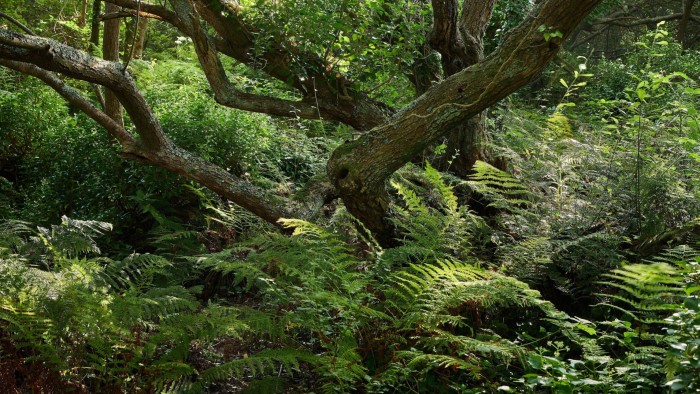Next time you go to scrape up that unloved moss, think again, says garden designer Zoe Claymore. It could just be the start of a rainforest. Moss, of various species, is the basis for her garden at this year’s Chelsea Flower Show created for the Wildlife Trusts. It will promote the charity’s 100-year project to preserve and expand the UK’s temperate rainforest, which at one time covered 20 per cent of the land — it now covers just 1 per cent.
They might not have the Technicolor creatures and steamy temperatures of their tropical counterparts, but temperate rainforests are similarly biomes whose lush vegetation, rich soil and high levels of biodiversity store enormous amounts of carbon — more than 1,000 tonnes per hectare. Rarer than tropical rainforests, they are found in areas of the UK, the US, Japan, New Zealand, Canada and Chile, where proximity to the sea creates mild and humid conditions.
Claymore herself spent some of her childhood playing in one of Britain’s few spots of rainforest, in Lydford Gorge, Devon, adjoining her grandparents’ garden. “It was magical. I liked the wildness of it,” she says: it was those memories she drew on when creating the design. After taking on the Wildlife Trusts project, she revisited Lydford and other rainforest sites, including Dart Valley Reserve in Devon, for inspiration. “The consistent elements,” she discovered, were “water; stone; native trees that are a little bit wonky and a little bit odd; ferns; mosses and lichen.”
Many of those plants might be seen as eyesores when they find their way into domestic gardens. Claymore hopes the Wildlife Trusts garden will urge visitors to rethink them: it’s a case of right plant, right place, she says. “If you’ve got three hours to kill on a Sunday why are you spending them scarifying moss out from somewhere it wants to live?”
The UK’s temperate rainforest has been decimated by deforestation for grazing land, but also by air and water pollution from the industrial revolution onwards. “It’s a long-standing problem,” says Ruth Swetnam, carbon and research manager for the Wildlife Trusts programme. “But I’d say the damage has accelerated in the past century.” Sheep and deer can cause damage, and invasive species such as rhododendrons can prevent rainforest species from regenerating.

Conserving and expanding what little is left is crucial. “It’s globally scarce. There are only a few places where a temperate rainforest can thrive,” Swetnam says. “We as a nation have a climate where it can, and we have a global responsibility [to look after it].”
The Chelsea garden features silver birch, hazel and field maple trees, as well as woodland plants such as foxgloves, English bluebells (“the Spanish ones are thugs,” says Claymore), red campion and cow parsley.
Moss, ferns and ivy are requisite components of these damp, shady rainforest environments. Ferns remind Claymore of “dinosaur land”, she says — they’re not just background artists. “There’s a huge variety of colours, ferns with different type of fronds, evergreen, deciduous, ferns for dry shade, wet shade — even sun. They can do so much. Because they’re less showy and don’t have flowers, people overlook them.”
Ivy, too, is unfairly denigrated, she says, often viewed as rampant and ripped out. “Ivy has a place, particularly our native ivy. It’s a tremendous source of food to birds in the winter, offers shelter for insects and is fabulous cover for a horrific fence.” For the apprehensive, there are some ivies that grow very small, she adds.


The Wildlife Trusts garden is designed with the rainforest of the milder, wetter, west coast of the UK in mind. However, those in sunnier or drier locations can use elements of the landscaping to create an adapted rainforest, says Claymore. Planting trees can provide shade where ferns will grow, as well as moss if it’s a damp corner. Field maple “tolerates a lot of pollution”, Claymore says, so suits urban gardens, as does hazel due to its small stature.
In natural rainforests, native trees such as oak, birch and holly, and plants growing epiphytically — such as moss, lichen and ferns — store considerable amounts of CO₂. Like peat bogs, they also soak up water, which could play a part in future flood defences. In periods of drought, their cool, damp interiors provide respite for wildlife.

The £38mn Temperate Rainforest Restoration programme, funded by insurer Aviva, enables the Wildlife Trusts to purchase 1,755 hectares of land for the planting of new rainforests. It will also fund its management for the next 100 years. The project began in 2023 and they estimate it will be responsible for sequestering 222,000 tonnes of carbon by 2050.
It is “a drop in the ocean”, though, says Swetnam. “What we’re trying to do is to inspire other people to help recreate and restore our rainforest. They’re national assets that we’re taking care of for the nation and they belong to every citizen.”
Find out about our latest stories first — follow @ft_houseandhome on Instagram
